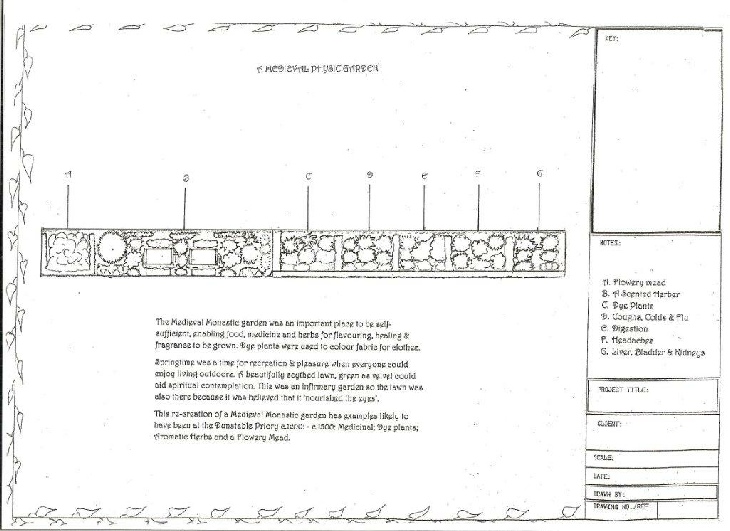
Medieval Dunstable© Webmaster Helen Mortimer Privacy Policy | Terms of Use



The Medieval Physic Garden
Author
Deborah Anne Bird
Physic garden Designer
The Medieval Monastic garden was an important place to be self-sufficient, enabling food, medicine and herbs for flavouring, healing & fragrance to be grown. Dye plants were used to colour fabric for clothes.
Springtime was a time for recreation & pleasure when everyone could enjoy living outdoors. A beautifully scythed lawn, green as velvet could aid spiritual contemplation. This was an infirmary garden so the lawn was also there because it was believed that it ‘nourished the eyes’.
This re-creation of a Medieval Monastic garden has examples likely to have been at the Dunstable Priory c.1200: - c.1500: Medicinal; Dye plants; Aromatic Herbs and a Flowery Mead.
Herbal medicines in the Middle Ages were used to treat some specific illnesses such as headache and aching joints - head pains were treated with sweet-smelling herbs such as rose, lavender, sage, and bay; a mixture of henbane and hemlock were applied to aching joints; Coriander was used to reduce a fever. Stomach pains and sickness were treated with wormwood, mint and balm.
Lung problems were given medicine made of liquorice and comfrey. Horehound cough syrups were prescribed for chesty head colds and coughs.
Wounds were cleaned with vinegar. Mint was also used in treating venom and wounds and Myrrh was used as an antiseptic. Yarrow, or Achillea was used to treat headaches and especially battle wounds.
Deborah Anne Bird
The Medieval Medicinal plants used in the Infirmary Garden
Liver, Bladder & Kidneys
Myrtle - Urinary infections
Lovage – Cystitis and Kidney stones
Dandelion – Diuretic (Sometimes known as ‘wet the bed’ to children)
Digestion
Vervain -Anti-diarrhoeic
Yarrow - Diarrhoea, biliary colic
Pennyroyal – Antispasmodic
Coughs Colds & Flu
Elecampane -Coughs, catarrh & asthma
Mallow - Calms irritated tissue of bronchitis
Sage – Antibacterial gargle tonsillitis, laryngitis
Headaches & Restorative Tonics
Thyme – To aid sleep in medieval times
St. John’s wort - Neuralgia, calming
English Lavender – Calming, insomnia & anti-depressive
The planting, or should we say replanting, of a Physic Border, or Herbarium in Priory Gardens has been managed by John Crawley, Head of Grounds & Environmental Services, at Dunstable Town Council. Designed and researched by landscape designer and local volunteer Deborah Bird with research support from Rae Bird and Hugh Garrod the Physic Border includes a wide range of plants that were grown during the medieval period to treat a variety of ailments. The border is also planted with dye plants and herbs commonly used during the period and a small area has been set aside to represent a flower mead popular at this time.
The raised beds are edged with green oak and a woven oak fence provides an attractive backdrop to the border. It was decided early on that the border should be a show case to represent the plants of the medieval period and whilst every effort has been made to source and use plants species of the period it has not been designed as a faithful recreation of a physic garden. The new border is a wonderful addition to the attractive gardens and with interpretation boards nearby it will provide visitors and school groups with good educational material about the plants of the period and their uses.
Those involved in the project have learnt a great deal about the plants of the period and with the local community and school children having helped to plant the border it is hoped that this part of the project will grow, flower and remain in good heart for years to come.

| Archaeology |
| Audio Guides |
| Education |
| Exhibitions |
| Events 2013 |
| Physic Garden |
| Priory History |
| Priory Churches / Lands |
| Town History |
| Virtual Tour |
| Website |
| Archaeology |
| Charters & Bylaws |
| Eleanor Cross |
| Famous People |
| The Fraternity |
| Friary |
| Guided Tours |
| History |
| Inns |
| Dunstable Treasures |
| Kingsbury |
| Middle Row |
| Royal Visits |
| Sheep & Wool Trade |
| The Town |
| Friary Archaeology |
| Bone Study |
| Friary |
| Annals Charters Valor Ecc |
| Archaeology |
| Churches and Lands |
| Guided Visits |
| Audio Guides |
| History |
| Monastic Life |
| Virtual Tour |
| The Augustinian Priory |
| The Canons Route |
| Bedfordshire |
| Buckingham |
| Derbyshire |
| Nothamptonshire |
| Hertfordshire |
| Leicestershire |
| Oxon |
| Priors |
| Annulment |
| History |
| Archives |
| Book Sales & Shop |
| Exhibitions |
| Guided Walks |
| Heritage Talks |
| Physic Gardens |
| Schools |
| Tourist Information Centre |
| Tea-room |
| Visits |
| Priory House Heritage Centre |
| Education |
| Knight |
| Search Results |